Installation height of the hood above a gas and electric stove: generally accepted standards
A kitchen hood is used to clean the air collected above the stove from particles of dust and grease, processed gas, and soot. And the height of the hood above a gas stove and other types of cooking surfaces affects the quality of operation of the device and its efficiency.
How to correctly calculate the height between the hood and the stove? What affects height? Are there any standards? And what happens if they are not followed? We will consider all these issues in detail in our article, focusing on the types of hoods for the kitchen and the rules for carrying out calculations and measurements.
The content of the article:
Types of kitchen hoods
Hoods are used to forcefully remove combustion products, various impurities (nitrogen oxide, carbon dioxide, various carcinogens) and unpleasant odors that appear in the air during cooking. This system operates on the principle of a vacuum cleaner.
A standard hood consists of the following elements: housing, electric motor, air intake, ventilation system, fatty (sometimes carbon) filters.

Depending on the method of removing processed air, devices are divided into circulation And flow-through. In the first case, the air, after purification and filtration, again enters the room, and in the second, it is discharged outside. Circulating ones are suitable if there is no ventilation in the house.
Not long ago, hoods began to appear that combine these two air handling technologies.
There are several types of hoods based on the installation method. Island, they are mounted on the ceiling. Corner fixed in the corner of the kitchen. Such models are suitable for small kitchens.
As for installation, then built-in The hood model can be easily hidden in a hanging cabinet. Dome are fixed on the wall. They perfectly complement the interior, but often come in large sizes.
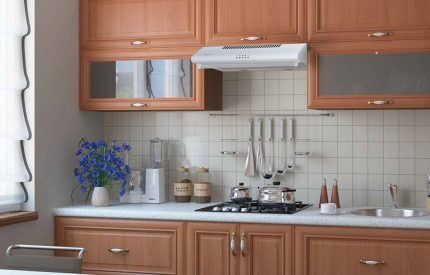
General recommendations for safe installation
But in order for any model of hood to work efficiently and fulfill its functions, it must be installed correctly. This task is best left to professionals.
So, the following factors influence the height of the hood:
- standard recommendations;
- type of stove or hob;
- the presence or absence of ventilation, as well as its power;
- device performance;
- hood dimensions;
- user height.
Since the main task of the device is to purify the air above the hob, when calculating the height you should base it, first of all, on the type and size of the stove itself.
There are stoves: gas, electric, induction and halogen. The peculiarity of the latter is considered Hi-Light burners.
To operate effectively, the hood must completely cover the hob area. Thanks to this, all polluted air will be recycled. If the stove is wider, then harmful impurities and unnecessary odors will remain in the kitchen.
For fire safety reasons, standard height parameters between the hood and the burners have been developed.
When compiling them, the type of stove and the design of the lower part of the hood are taken into account. It can be straight or inclined.
For gas stoves, the height from the burners to the straight hood is from 75 to 85 cm, and to the inclined hood is 55-65 cm.
For electric, induction and halogen surfaces, the height from the burners to the direct hood is from 65 to 75 cm, and to the inclined hood - from 35 to 45 cm.
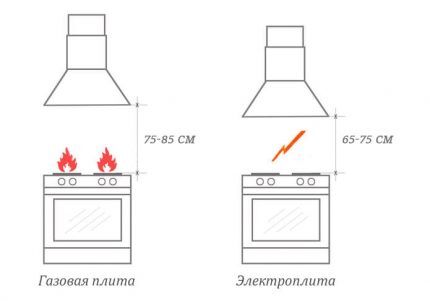
Often the manufacturer himself prescribes the required height. This is dictated by the characteristics of the materials from which the filters and the device itself are made. The material may be particularly flame resistant and/or have some special features.
You can deviate from the established standards by a maximum of 5-10 centimeters. The distance can only be increased, and reduced only if the power allows and the height of the cook requires it. In any case, before making a final decision, you should consult a specialist.
Professional installation will allow the device to perform its functions better and more efficiently (to extract all excess and purify the air), and will also save energy, since you will not have to turn on the hood at maximum power.
In addition, the height between the hood and the hob is affected by the performance of the hood itself. Sometimes this indicator is called power and is measured in cubic meters. m/hour. Before purchasing a hood, it is worth calculating at least an approximate value.
The quality of air purification directly depends on productivity. Also, if the device has sufficient power, you can adjust the height of the hood above the hob.
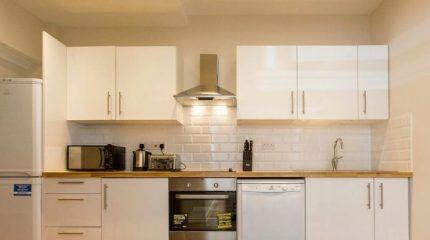
No. 1 - installing a hood over a gas stove
There are many requirements for appliances that are installed above a gas stove. First, you need to accurately measure the distance from the bottom of the device to the hob. As mentioned above, it should be within 75-85 cm.
This distance is slightly greater than when installing the device above an electric model due to the fact that an open flame can ignite the hood filters, especially if they are heavily dirty.
Also, we should not forget that in the case of gas stoves, natural ventilation must work. Therefore, during installation, you cannot completely block the ventilation hole in the kitchen.
To avoid this, you can purchase special grilles for air ducts, divided into two parts: one for hood connections, and the other for natural ventilation.
The extraction power is also a very important parameter. Before purchasing a unit, it is necessary to accurately calculate it. A little below will be written about how to do this correctly.
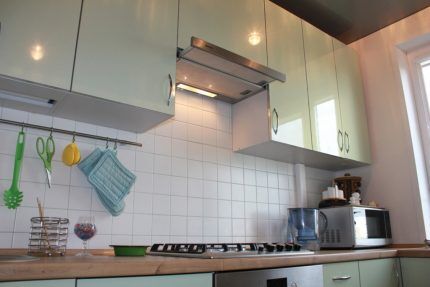
Do you want to install a hood over a gas stove yourself? In this case, we recommend that you look step-by-step instructions on installation.
No. 2 - distance to the electric stove
More lenient requirements are being put forward for electric models. First of all, this concerns the installation height of the hood above the device - it can be reduced slightly, since these models are considered safer to use than gas models.
If the kitchen space is small, then the best option would be to opt for a built-in or flat hood model. In addition to convenience, the prices for such devices are affordable for most citizens.
Another important factor that needs to be taken into account when placing the device above the hob is the dimensions of the stove. So, the width and length of the hood should not be less than the same parameters of the slab. Otherwise, grease and soot will accumulate on the furniture.
We have provided detailed instructions for installing a kitchen hood on your own in this article.
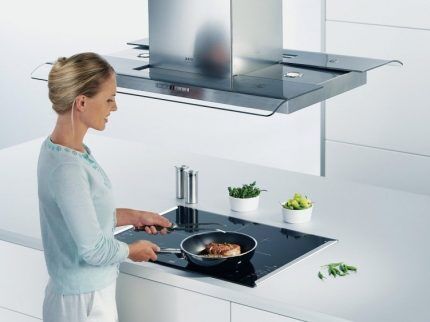
Carrying out measurements and calculations
As you can see, it is quite difficult to take into account all the factors and make an accurate calculation. But you need to try not to regret purchasing a device that cannot cope with the tasks assigned to it.
There are criteria developed by manufacturers:
- A device with a capacity of 200 to 300 cubic meters. m/hour is suitable for those who cook little or have a small kitchen. That is, 1-2 burners are constantly used.
- Hood with a capacity of 300 to 400 cubic meters. m/hour is recommended for families of 3-4 people, or for a medium-sized kitchen, as well as where 2-3 burners are used daily.
- A device with a capacity of 500-600 cubic meters. m/hour will clean the air in a large kitchen and cover the needs of a large family.Such a hood will be indispensable if the stove is actively used every day and all burners are turned on (there may be 5-6 of them).
For approximate indicators, you can use special tables or data from manufacturers.
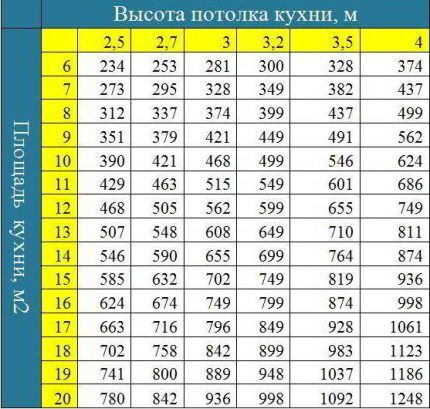
If the kitchen has non-standard dimensions or its area does not exceed 40 cubic meters. m, then calculate this value for a specific room by simply multiplying the length of the kitchen by its width and the height of the ceilings. The result must be multiplied by 10 or 12
The numbers 10 or 12 are constant coefficients based on sanitary standards. They mean that the air must be cleaned every 5 minutes, that is, 10-12 times per hour. Therefore, productivity exceeds the volume of the kitchen by at least 10-12 times.
Sometimes this coefficient increases due to the frequency of switching on and the characteristics of the stove used. For example, for a gas stove with large burners that are turned on every day, this number can reach 20. For an electric stove, you can take a factor of 15.

For example, the length and width of the kitchen are 2 and 3 m, respectively, and the ceiling height is 2.5 m.
Therefore, the estimated performance will be: 2 * 3 * 2.5 * 10 = 150 cu. m/hour.
This figure can be multiplied by the number of storeys factor of 1.3. It meets sanitary standards.
If someone smokes in the kitchen, then another 15% is added to productivity for each smoker of the total number.
The data obtained is correct for enclosed spaces. If the kitchen is not closed by a door, but is separated from other rooms by a passage, then another 30% of the received power should be added.
We have detailed instructions on our website calculation kitchen hoods.
The next indicator is considered chef's height. It is very important that the hood does not touch your head and does not interfere with reaching distant burners or placing large pans.
Therefore, before purchasing and installing, take measurements and simulate the process of working behind the stove. To avoid mistakes when taking measurements, remember that an inclined hood should be measured from the lowest point to the burners.
All straight hoods (dome or built-in) should be measured from the filters to the slab surface.
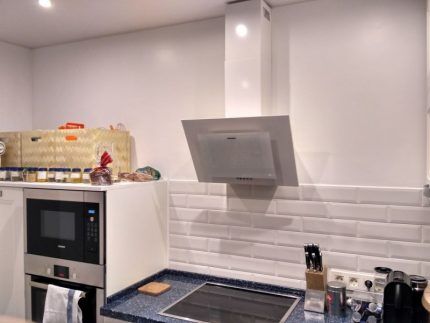
It should also be taken into account draw length. Determine how much it will protrude above the hob, how convenient it will be to cook and replace coal and grease filters, as well as wash the stove and reach distant burners.
All described factors affecting the distance must be consistent. Otherwise, there is a risk that the hood will not cope with its tasks. Even the most powerful device installed too high will not cope with all the impurities in the air. Or soot that has settled on the bottom of a hood that is installed too low may ignite.
A competent choice of installation height will extend the life of the hood and allow the device to work at full capacity with minimal costs. In the worst case, the device may not cope with its functions or simply burn out.
What else to consider during installation?
Before installation, you should consider the specifics of connecting the device to the network.
Any hood is connected to the electrical network. Therefore, the socket should be installed at a height of 2 -2.5 meters from the floor and 15-25 cm above the wall cabinets.
Such an outlet must be grounded so that the hood does not burn out due to power surges. Never install an outlet in line with an air duct. Aim for about 15-20 cm from it.
Also, when taking measurements, it is worth considering the distances to the side cabinets. Aim for 5-10 cm in both directions.
We have provided diagrams of the location of sockets in the kitchen and the details of their installation with our own hands in next material.
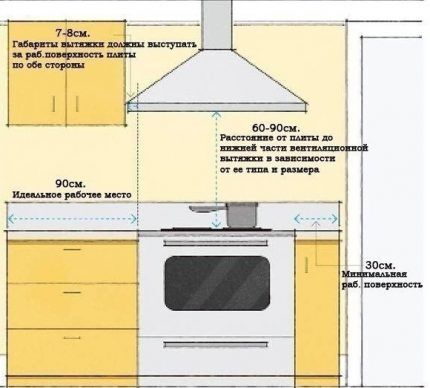
For example, let's look at a specific situation. The dome hood must be installed above a 5-burner gas stove in a 31-cu.m. kitchen. m, ceiling height 2.8 m. Cooking is done on the stove every day, the kitchen is closed with a door.
First, let's find out the approximate power. Let’s take the coefficient 20 due to the number of burners and the frequency of use of the stove: 31 * 2,8 * 20 = 1736.
Thus, this kitchen requires a hood with a capacity of at least 1800 cubic meters. m/hour.
The stove will be used by a person with a height of 170 cm, the height of the stove is 75 cm, and the height of the hood is 60 cm. Therefore, we compare all the data and get an approximate range of 77-80 cm for the height of the hood.
It is important to carry out such calculations to avoid errors during installation. But it’s best if you have the opportunity to check the conventional arrangement of equipment in the kitchen and the ease of its use.
Conclusions and useful video on the topic
From the video you can find out at what height you should install the hood and why it is important to adhere to these standards:
Calculating the required height of the hood above the surface of the slab is important for each case. Use the tips given in the article, do the calculations and then there will always be fresh and clean air in your kitchen.
Do you still have questions after reading our publication? Ask them in the comments block - our experts will try to help you.
Or maybe you have comments, additions, or have you noticed inaccuracies in the material presented above? Please write to us about this below the article.




I was faced with the question: what kind of hood should I install in the kitchen? And after reading a lot of information, I decided to order for 1000 cubic hours. Personally, I installed a 90 cm wide hood on a 60 cm hob. This is so that all the cabinets on the sides are not constantly covered in grease, and the hood can handle it with ease. I installed it at a height of 80 cm from the gas surface, as indicated here. Everything is correct, because the filters can catch fire and remove odors more effectively. Therefore, take into account all the nuances.
I'm glad to hear that this article helped you choose the necessary hood that is suitable for your kitchen and hob in particular in terms of technical characteristics.
Regarding the ignition of grease filters, for such a dangerous situation it must take some time (a year or two) for a sufficiently thick layer of grease and dust to form. How and what is the best way to wash hood grates is described in this article plus there are some tips in the comments.
Regarding the fact that you can place the hood lower above the electric stove, I have a remark, especially relevant for tall people. Even the picture in the article shows that a hood at such a height bothers a woman. Also take into account the location of the hood so as not to hit your head on it while cooking.
My hood hangs above the gas stove 71 cm from the burners, you write that the minimum is 75. How critical can this be? Remodeling is quite problematic; you will have to redo or change the cabinet. But I don’t want to neglect safety either.
If the hood has a metal body, then it’s fine. As far as I remember, the critical height is considered to be 65 cm. To clear your conscience, you can wash off the grease from the filters/grease collection grids more often.
And we got the hood along with the apartment we bought from the old tenants. And I have a feeling that she is not quite coping with her responsibilities. At the same time, it stands right next to the cabinets, meaning there is nothing to be done about the size. I measured the distance to the comforter - it seems to be normal. Maybe you can somehow change the motor to a new, more powerful one or clean the old motor?
It’s best for you to calculate what power you need from the hood, and then think about further actions. In fact, you can change the motor in the hood if you wish, but this is a rather expensive part.Or maybe it’s true that the old engine is simply clogged with grease and is having difficulty drawing air out. Then it needs to be disassembled and coated with silicone or machine oil. Plus clean the filters and motor impellers.
In general, all this is necessary prevention. If you do not do this, the hood will very soon become unusable.
Before upgrading your hood, Maria, I recommend checking its effectiveness. The methods are listed in the article “How to check ventilation in an apartment", published on this site.
Please note that the hood requires adequate air flow. To ensure normal operation, test the operation of the hood with the window in the kitchen closed and slightly open.
If possible, buy an anemometer (prices for models start from ₽800), which allows you to measure the performance of the hood, efficiency apartment ventilation – an instrument test will reveal the true cause. After all, it may turn out to be to blame ventilation duct. For example, it is not designed to work with a hood.
Hello. I have a retractable flow-through hood, metal, the height above the gas stove is 58 cm. How critical is this situation?
Thank you.
Hello, I need your help: kitchen 24 sq/m.. gas stove with 4 burners (60), I choose a hood for size 90 and 1200 cubic meters per hour... is this normal?! Or is it better to buy a hood for size 60 width?!